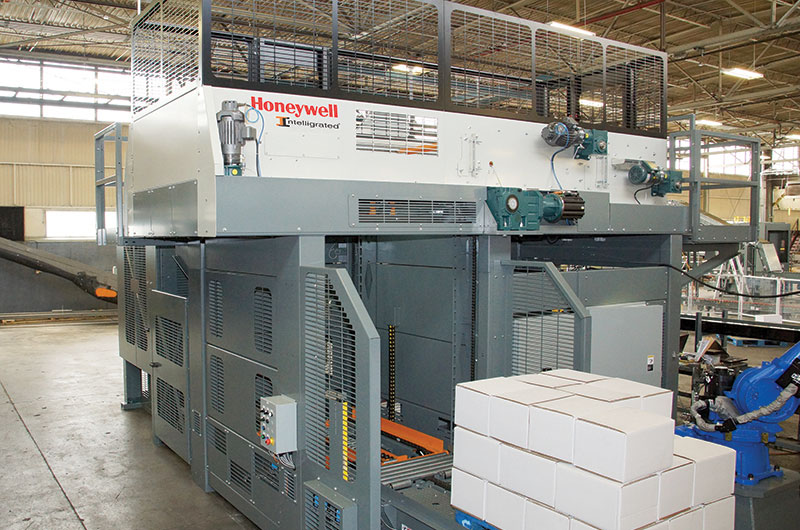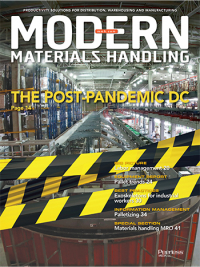Palletizing for the digital age
From sequencing to assembly to movement through the supply chain, pallet loads are transforming from bulk deliveries to precise allocations.
For all the talk about e-commerce and the increased demand for piece picking, you’d think the pallet is so 1999. But in Modern’s last three surveys of pallet users, more than 90% of respondents indicated they were using the same or more pallets than the prior year. Yes, we’re shipping more parcels than ever before, but when it comes to getting product from Point A to Point B in truckload and less-than-truckload quantities, the pallet is still indispensable.
More pallets translates into more opportunities for automated palletizing and its cousin, automated depalletizing. In part, that’s being driven by the need for efficiency. In a mass production environment, where thousands of uniform cases are coming off the line and going onto pallets for reserve storage, a palletizer is the most cost-effective way to go.
It’s also being driven by the shortage of labor willing to work in manual palletizing and depalletizing operations: For proof, look no further than the story Modern ran on Varner’s highly automated distribution center in the March 2020 issue. And, in part, it’s being driven by the end user demand for mixed SKU pallets, end-of-aisle promotional pallets and store-ready, aisle-aligned pallets. As an example, the ES3 facility Modern visited a few years ago in Pennsylvania used robotic palletizers to build store-ready pallets for grocery customers. And, in some instances, it’s being driven by all of the above: Consider the L’Oreal distribution center near Louisville using layer-picking robotic palletizers to build mixed SKU pallets in part because customers demanded it and in part because the cosmetics manufacturer had trouble staffing a third shift.
“We’ve been talking about labor availability for quite some time, and now that problem is on steroids,” says Matt Wicks, chief robotics solution architect at Honeywell Intelligrated and chair of the Robotic Industries Association (RIA) board of directors. “I’m biased, but in the context of warehousing and distribution, we’re going to require more sophisticated robotics to perform activities that are done manually today.”
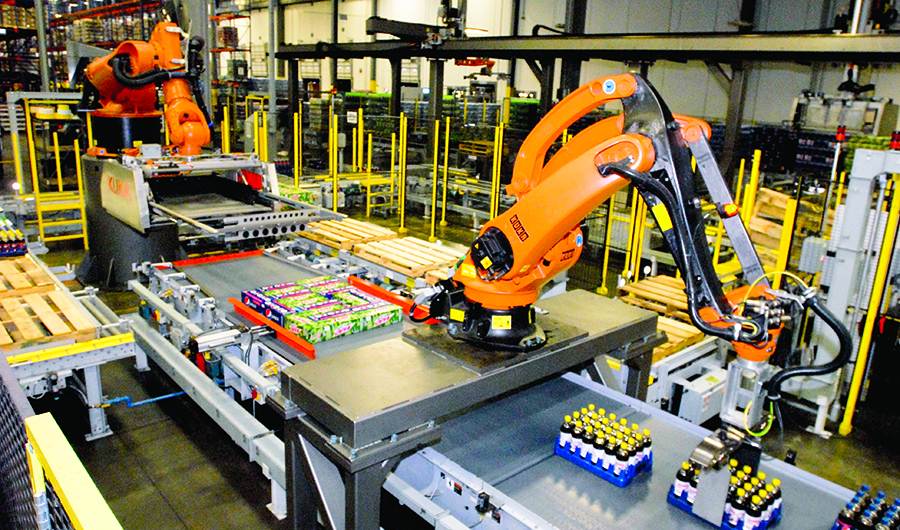
Operations struggling to find labor are turning to the enhanced capabilities of the latest automated palletizing equipment.
Addressing complexity with software
Automation loves predictability and simplicity. For that reason, automatically building a single SKU pallet is primarily about speed. Sure, the pattern might change with a new product or new size carton, but that new pattern can be easily stored in the system’s memory. Building mixed SKU pallets, on the other hand, is unpredictable and complex, since no two orders are likely to be the same.
These days the demand for mixed SKU pallets is becoming commonplace, notes Ken Ruehrdanz, manager of the distribution systems market for Dematic, as distribution centers and stores try to minimize the amount of stock they keep on hand at any given time.
Building the pallets can be a bit of a jigsaw puzzle, that includes not just figuring out how to maximize the cube of the pallet to get the most product on a truck, but also building a stable pallet as well as one that takes into consideration factors like crushability—you don’t want cartons of soup stacked on top of potato chips or cookies in a pallet destined for a grocery store, for instance.
One solution to the mixed SKU pallet, according to Ruehrdanz, is to take a systematic approach. The idea is to combine automated pallet storage and depalletizing followed by buffer storage of cases that are then released so that robotic palletizers can build pallets in the right sequence for delivery to the store and stocking the shelves.
That’s a tall order, according to Ruehrdanz, that is now managed by a warehouse execution system (WES) that tracks the location of each case from incoming to storage to sequencing to pallet building, along with the planograms of the stores being served and the orders to be filled. And, it does so by enforcing the business rules highlighted above, such as the route stop sequence for direct store delivery, heavy cases on the bottom and lighter case on top and optimal trailer density.
The WES system must also have visibility beyond the four walls of the distribution center to coordinate with upstream flows, adds Linda Grady, national account manager for the systems group at Bastian Solutions. For example, Grady says good software can sequence when to withdraw the pallet, find an ideal staging area, and coordinate between the WES and WMS to determine which pallets to depalletize in which order. “With visibility of what’s being staged in front of the depalletizing area, you can have a pull methodology so everything that goes onto the conveyor has a destination, instead of putting things on and finding a destination later,” Grady says.
Aside from changes within a pallet or within a facility, Mark Dickinson, director of enterprise solutions for SSI Schaefer Systems International, predicts software will be required to manage changes in the movement of pallets throughout the supply chain. “I think it will come to a point where instead of sending a pallet to my DC from the manufacturer, it will be broken down and shipped direct to the customer to save time,” he says. “We will see that in grocery where there’s a need, or opportunity, to cut out a day between order and delivery.”
New palletizing frontiers
While automated palletizing has traditionally taken place on the manufacturing line, the mixed SKU palletizing described above has moved to the distribution center. Data is critical to make that transition, says Honeywell Intelligrated’s Wicks. And, in the case of robotic palletizing, that data may extend beyond the SKU, weight and package dimensions that are typically taken into consideration in manufacturing. “For example, in order for a robotic palletizer to do manipulation, you also have to know whether it’s a clear plastic bag, so that the robot can approach grasping and placing in a certain way,” Wicks says. “That data doesn’t exist in traditional palletizing.” Wicks recommends a pilot program to collect data and then assess the solution’s compatibility with the application.
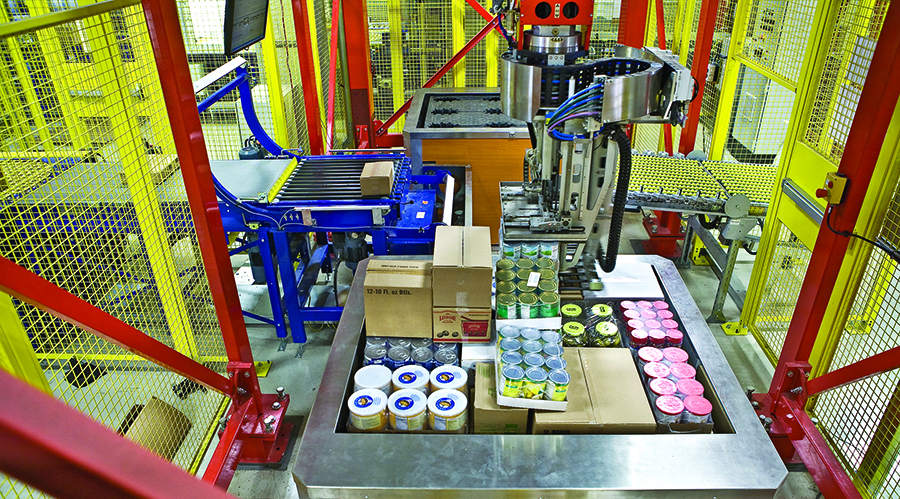
Automated palletizing solutions are better than ever at handling variations in SKUs, orders, patterns and customer preferences.
There are also opportunities to use automation to bring more efficiency to manual palletizing processes. For instance, Jake Heldenberg, a sales consultant at Vanderlande, describes processes in which donor pallets are stored in an AS/RS, cases are delivered to the palletizing area from a mini-load and an automatic guided vehicle (AGV) delivers the finished pallets to the dock for order consolidation. Meanwhile, palletizing is still manual. In that example, associates are responsible for the value-added process of building a pallet, while automation handles non-value-added storage and travel.
Embracing the next generation
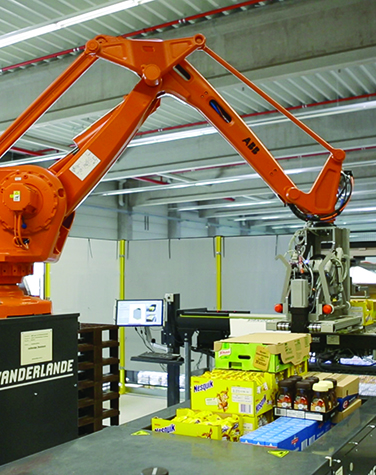 David Schwebel, senior vice president and global head of intralogistics for Grenzebach Corp., notes that the disruption many manufacturing and distribution operations are experiencing today, could be an opportunity to revitalize palletizing operations. He recalls as craft beer sales began to explode just a few years ago that beverage distribution centers were tasked almost overnight with building layered, tiered, rainbow and spiral pallets to keep up with demand. Since, they’ve been doing it with palletizers and software systems that were put into operation decades ago. “Multiply that by 50 DCs, and it’s an exponential increase in complexity being handled by obsolete technology,” he says.
David Schwebel, senior vice president and global head of intralogistics for Grenzebach Corp., notes that the disruption many manufacturing and distribution operations are experiencing today, could be an opportunity to revitalize palletizing operations. He recalls as craft beer sales began to explode just a few years ago that beverage distribution centers were tasked almost overnight with building layered, tiered, rainbow and spiral pallets to keep up with demand. Since, they’ve been doing it with palletizers and software systems that were put into operation decades ago. “Multiply that by 50 DCs, and it’s an exponential increase in complexity being handled by obsolete technology,” he says.
Those companies exploring the equipment market for the first time in years are discovering that palletizing hardware is faster, safer and more reliable. And, while making changes to older manufacturing and distribution software stacks is also a risk, Schwebel argues the rewards are worth it. “Tack on the improvements in algorithms, and the ability to build very unique pallets is a strategic advantage that leads to happier customers, increased sales, reduced inventory and makes the lives of operations managers easier,” he says. These are the kinds of times when companies are reluctant to spend, “but I argue that this could the best time to shut down manufacturing and get this done.”
Depalletizing comes of age
While mixed-SKU palletizing has been around for some time, it still requires a significant capital investment to do it right, says Honeywell Intelligrated’s Matt Wicks.
Depalletizing, on the other hand, takes labor out of the process and is an easier process to tackle. “You don’t have to be smart about how you build a pallet,” he says, “You just have to remove product.”
Linda Grady from Bastian agrees. She cites several projects where a DC needs to induct a mixed pallet from another DC into the order processing system. In most facilities, that’s done manually, in part because of the random nature of the product that has to be handled.
But thanks to new algorithms and partnerships with 3D vision companies, robots can now handle that process. “In the past, pallet patterns were so irregular it was hard for automatic depalletizing,” she says. “With vision systems, you can handle the unknown at a much faster rate so there’s an ROI where previously it might not have made sense.”
As the technology improves, Wicks predicts that robotic depalletizing applications will build momentum. As users build more understanding of products and data, it will naturally enable them to pursue more sophisticated capabilities.
Companies mentioned in this article:
- Bastian Solutions
- Dematic
- Grenzebach Corp.
- Honeywell Intelligrated
- SSI Schaefer Systems International
- Vanderlande

Article Topics
Shipping Pallets News & Resources
Two voices of reason on pallet materials Pallet recycler and services company PLA appoints Steve Clark as CEO Cobot as key ingredient for palletizing efficiency CHEP appoints Xavier Garijo to newly created CEO Americas position Pallet company Kamps announces executive team changes PLA names Jenny Bedard as new CFO Moving pallets at Aurobindo More Shipping PalletsLatest in Materials Handling
Materials Handling Robotics: The new world of heterogeneous robotic integration Lucas Watson appointed CSO for Körber’s Parcel Logistics business in North America Hyster recognizes Dealers of Distinction for 2023 Carolina Handling names Joe Perkins as COO C-suite Interview with Keith Moore, CEO, AutoScheduler.AI: MODEX was a meeting place for innovation Walmart deploying autonomous lift trucks at four of its high-tech DCs Coles shops big for automation More Materials HandlingAbout the Author
Subscribe to Materials Handling Magazine

Find out what the world's most innovative companies are doing to improve productivity in their plants and distribution centers.
Start your FREE subscription today.
April 2024 Modern Materials Handling

Latest Resources


